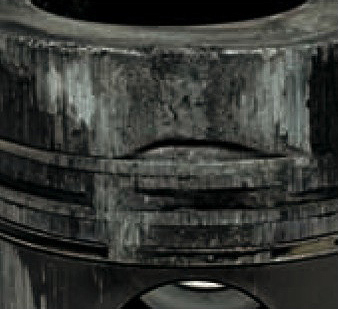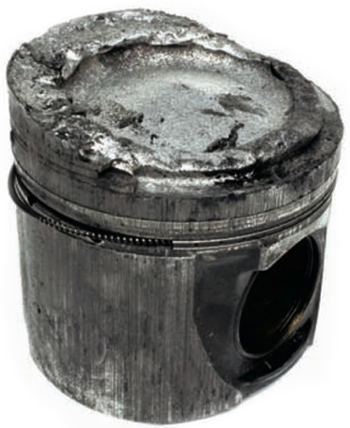Engine damage resulting in melted piston tops and ring lands may be found in several stages outlined in this bulletin, ranging from light damage at the piston to catastrophic engine failure.

Signs of melted piston or ring land damage include:
• Erosion at the piston crown is visible.
• Melted areas can be seen at the piston crown (Fig. 1) – right up to a completely melted off top of the piston (Fig. 2).
• In extreme cases, there are seizure marks all along and around the piston. There is a hole in the piston.
PROBABLE CAUSES
This damage is attributed to the thermal overload of the piston.
There are two causes for this.
Abnormal combustion can be diagnosed via the following features:
• The bowl edge has been “gnawed off.”
• The injection nozzles display a poor spray pattern.
• The injection pressure and the delivery rate of the injection nozzles are set incorrectly.
• The top land shows seizure marks in the piston pin axis.

An abnormal combustion can be caused by a number of factors such as if the air-fuel mixture in the combustion chamber is too rich. This can be the result of the following:
• The air supply is reduced, e.g. the air filter is clogged.
• The fuel delivery is set incorrectly.
• The start of fuel delivery is set incorrectly.
• The nozzle needle is either wedged or stiff.
• The exhaust gas system is clogged.
There is ignition delay and misfiring, which may be caused by:
• The incorrect fuel or fuel with an insufficient cetane rating is being used, or there is gasoline in the diesel.
• The valves are leaky, resulting in compression loss.
• The protrusion is too small (i.e., there is insufficient compression).
• The air pre-warming is defective (especially for very low ambient temperatures).
Overheating of the piston crown can be identified via the following features:
• The combustion bowl is not damaged.
• An excellent spray pattern can be observed at the top of the piston.
The excessive temperature level of the piston crown can be caused by:
• The cooling oil nozzle is either bent, has become detached or has not been assembled (assembly error).
• The time between oil changes is too long. In this case, there is a risk of polymerization of the engine oil, especially when using biofuels, such as rapeseed and soybean oil, which can result in the cooling oil nozzles being clogged.
• Contamination, such as gasket residue, etc., prevents the required circulation in the oil circuit.
SOLUTION
• Set the injection amount and timing according to the manufacturer’s specifications.
• Check the injection nozzles for any leaks, the injection pressure and the spray pattern.
• Pay attention to correct alignment when assembling the cooling oil nozzles.
• Thoroughly clean the oil channels in the engine block, the crankshaft and the cylinder head.
• Make sure the pressure-regulating valve is functioning correctly.
• Ensure that the time between oil changes is much shorter when running the engine on biofuels.
Tech Tip courtesy of MAHLE Clevite.













